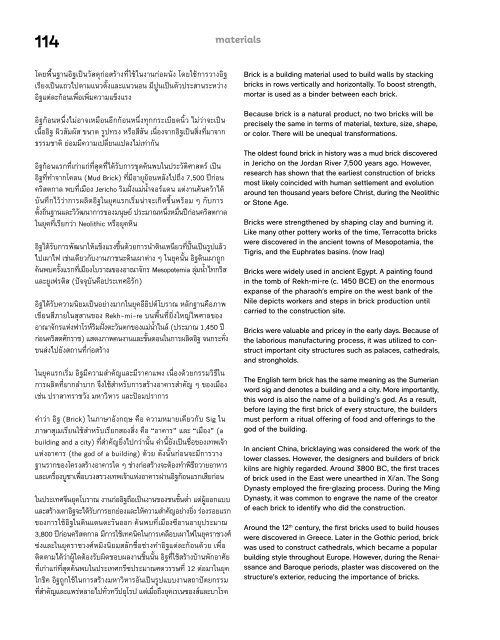ASA Journal 16/2023
Create successful ePaper yourself
Turn your PDF publications into a flip-book with our unique Google optimized e-Paper software.
114<br />
materials<br />
โดยพื้นฐานอิฐเป็นวัสดุก่อสร้างที่ใช้ในงานก่อผนัง โดยใช้การวางอิฐ<br />
เรียงเป็นแถวไปตามแนวตั้งและแนวนอน มีปูนเป็นตัวประสานระหว่าง<br />
อิฐแต่ละก้อนเพื่อเพิ่มความแข็งแรง<br />
อิฐก้อนหนึ่งไม่อาจเหมือนอีกก้อนหนึ่งทุกกระเบียดนิ้ว ไม่ว่าจะเป็น<br />
เนื้ออิฐ ผิวสัมผัส ขนาด รูปทรง หรือสีสัน เนื่องจากอิฐเป็นสิ่งที่มาจาก<br />
ธรรมชาติ ย่อมมีความเปลี่ยนแปลงไม่เท่ากัน<br />
อิฐก้อนแรกที่เก่าแก่ที่สุดที่ได้รับการขุดค้นพบในประวัติศาสตร์ เป็น<br />
อิฐที่ทำาจากโคลน (Mud Brick) ที่มีอายุย้อนหลังไปถึง 7,500 ปีก่อน<br />
คริสตกาล พบที่เมือง Jericho ริมฝั่งแม่น้ำาจอร์แดน แต่งานค้นคว้าได้<br />
บันทึกไว้ว่าการผลิตอิฐในยุคแรกเริ่มน่าจะเกิดขึ้นพร้อม ๆ กับการ<br />
ตั้งถิ่นฐานและวิวัฒนาการของมนุษย์ ประมาณหนึ่งหมื่นปีก่อนคริสตกาล<br />
ในยุคที่เรียกว่า Neolithic หรือยุคหิน<br />
อิฐได้รับการพัฒนาให้แข็งแรงขึ้นด้วยการนำาดินเหนียวที่ปั้นเป็นรูปแล้ว<br />
ไปเผาไฟ เช่นเดียวกับงานภาชนะดินเผาต่าง ๆ ในยุคนั้น อิฐดินเผาถูก<br />
ค้นพบครั้งแรกที่เมืองโบราณของอาณาจักร Mesopotemia ลุ่มน้ำ าไทกริส<br />
และยูเฟรติส (ปัจจุบันคือประเทศอิรัก)<br />
อิฐได้รับความนิยมเป็นอย่างมากในยุคอียิปต์โบราณ หลักฐานคือภาพ<br />
เขียนสีภายในสุสานของ Rekh-mi-re บนพื้นที่ยิ่งใหญ่ไพศาลของ<br />
อาณาจักรแห่งฟาโรห์ริมฝั่งตะวันตกของแม่น้ำ าไนล์ (ประมาณ 1,450 ปี<br />
ก่อนคริสตศักราช) แสดงภาพคนงานและขั้นตอนในการผลิตอิฐ จนกระทั่ง<br />
ขนส่งไปยังสถานที่ก่อสร้าง<br />
ในยุคแรกเริ่ม อิฐมีความสำาคัญและมีราคาแพง เนื่องด้วยกรรมวิธีใน<br />
การผลิตที่ยากลำาบาก จึงใช้สำาหรับการสร้างอาคารสำาคัญ ๆ ของเมือง<br />
เช่น ปราสาทราชวัง มหาวิหาร และป้อมปราการ<br />
คำาว่า อิฐ (Brick) ในภาษาอังกฤษ คือ ความหมายเดียวกับ Sig ใน<br />
ภาษาสุเมเรียนใช้สำาหรับเรียกสองสิ่ง คือ “อาคาร” และ “เมือง” (a<br />
building and a city) ที่สำาคัญยิ่งไปกว่านั้น คำานี้ยังเป็นชื่อของเทพเจ้า<br />
แห่งอาคาร (the god of a building) ด้วย ดังนั้นก่อนจะมีการวาง<br />
ฐานรากของโครงสร้างอาคารใด ๆ ช่างก่อสร้างจะต้องทำาพิธีถวายอาหาร<br />
และเครื่องบูชาเพื่อบวงสรวงเทพเจ้าแห่งอาคารผ่านอิฐก้อนแรกเสียก่อน<br />
ในประเทศจีนยุคโบราณ งานก่ออิฐถือเป็นงานของชนชั้นต่ำ า แต่ผู้ออกแบบ<br />
และสร้างเตาอิฐจะได้รับการยกย่องและให้ความสำ าคัญอย่างยิ่ง ร่องรอยแรก<br />
ของการใช้อิฐในดินแดนตะวันออก ค้นพบที่เมืองซีอานอายุประมาณ<br />
3,800 ปีก่อนคริสตกาล มีการใช้เทคนิคในการเคลือบเผาไฟในยุคราชวงศ์<br />
ซ่งและในยุคราชวงศ์หมิงนิยมสลักชื่อช่างทำาอิฐแต่ละก้อนด้วย เพื่อ<br />
ติดตามได้ว่าผู้ใดต้องรับผิดชอบผลงานชิ้นนั้น อิฐที่ใช้สร้างบ้านพักอาศัย<br />
ที่เก่าแก่ที่สุดค้นพบในประเทศกรีซประมาณศตวรรษที่ 12 ต่อมาในยุค<br />
โกธิค อิฐถูกใช้ในการสร้างมหาวิหารอันเป็นรูปแบบงานสถาปัตยกรรม<br />
ที่สำาคัญและแพร่หลายไปทั่วทวีปยุโรป แต่เมื่อถึงยุคเรเนซองส์และบาโรค<br />
Brick is a building material used to build walls by stacking<br />
bricks in rows vertically and horizontally. To boost strength,<br />
mortar is used as a binder between each brick.<br />
Because brick is a natural product, no two bricks will be<br />
precisely the same in terms of material, texture, size, shape,<br />
or color. There will be unequal transformations.<br />
The oldest found brick in history was a mud brick discovered<br />
in Jericho on the Jordan River 7,500 years ago. However,<br />
research has shown that the earliest construction of bricks<br />
most likely coincided with human settlement and evolution<br />
around ten thousand years before Christ, during the Neolithic<br />
or Stone Age.<br />
Bricks were strengthened by shaping clay and burning it.<br />
Like many other pottery works of the time, Terracotta bricks<br />
were discovered in the ancient towns of Mesopotamia, the<br />
Tigris, and the Euphrates basins. (now Iraq)<br />
Bricks were widely used in ancient Egypt. A painting found<br />
in the tomb of Rekh-mi-re (c. 1450 BCE) on the enormous<br />
expanse of the pharaoh’s empire on the west bank of the<br />
Nile depicts workers and steps in brick production until<br />
carried to the construction site.<br />
Bricks were valuable and pricey in the early days. Because of<br />
the laborious manufacturing process, it was utilized to construct<br />
important city structures such as palaces, cathedrals,<br />
and strongholds.<br />
The English term brick has the same meaning as the Sumerian<br />
word sig and denotes a building and a city. More importantly,<br />
this word is also the name of a building’s god. As a result,<br />
before laying the first brick of every structure, the builders<br />
must perform a ritual offering of food and offerings to the<br />
god of the building.<br />
In ancient China, bricklaying was considered the work of the<br />
lower classes. However, the designers and builders of brick<br />
kilns are highly regarded. Around 3800 BC, the first traces<br />
of brick used in the East were unearthed in Xi’an. The Song<br />
Dynasty employed the fire-glazing process. During the Ming<br />
Dynasty, it was common to engrave the name of the creator<br />
of each brick to identify who did the construction.<br />
Around the 12 th century, the first bricks used to build houses<br />
were discovered in Greece. Later in the Gothic period, brick<br />
was used to construct cathedrals, which became a popular<br />
building style throughout Europe. However, during the Renaissance<br />
and Baroque periods, plaster was discovered on the<br />
structure’s exterior, reducing the importance of bricks.

















